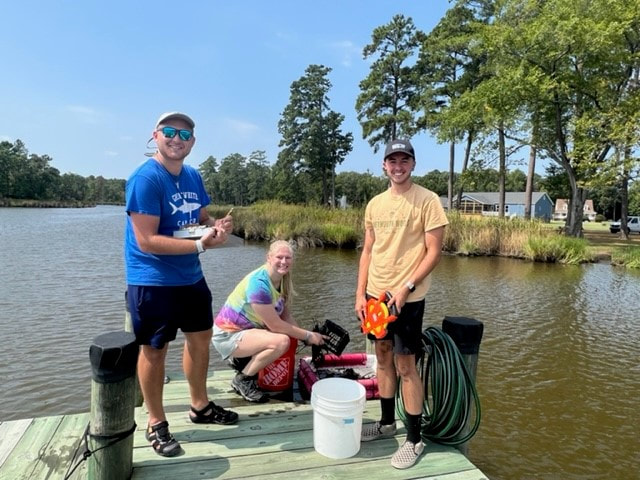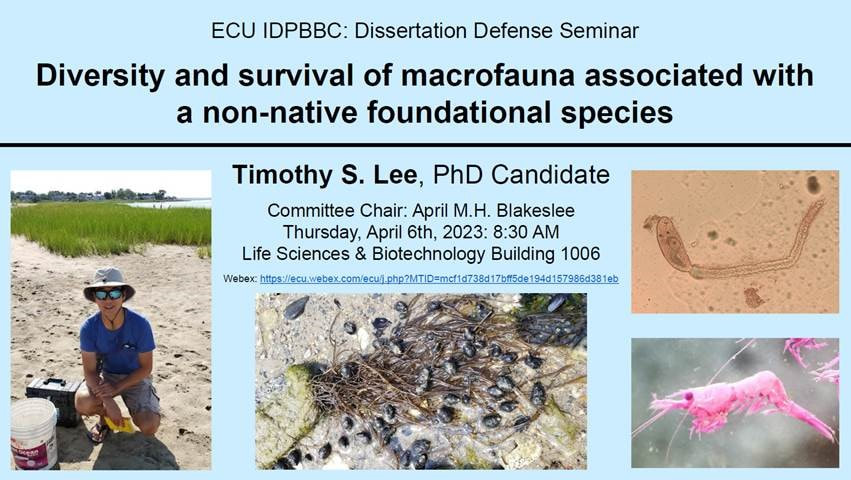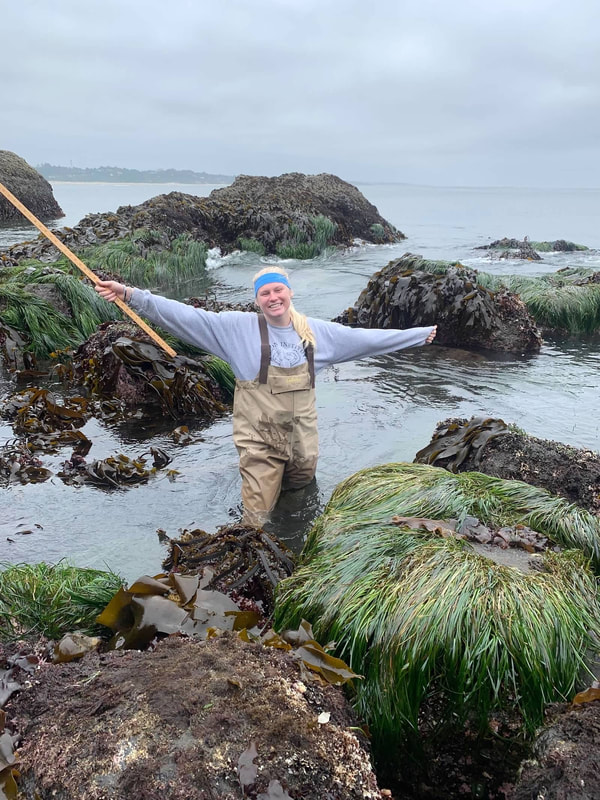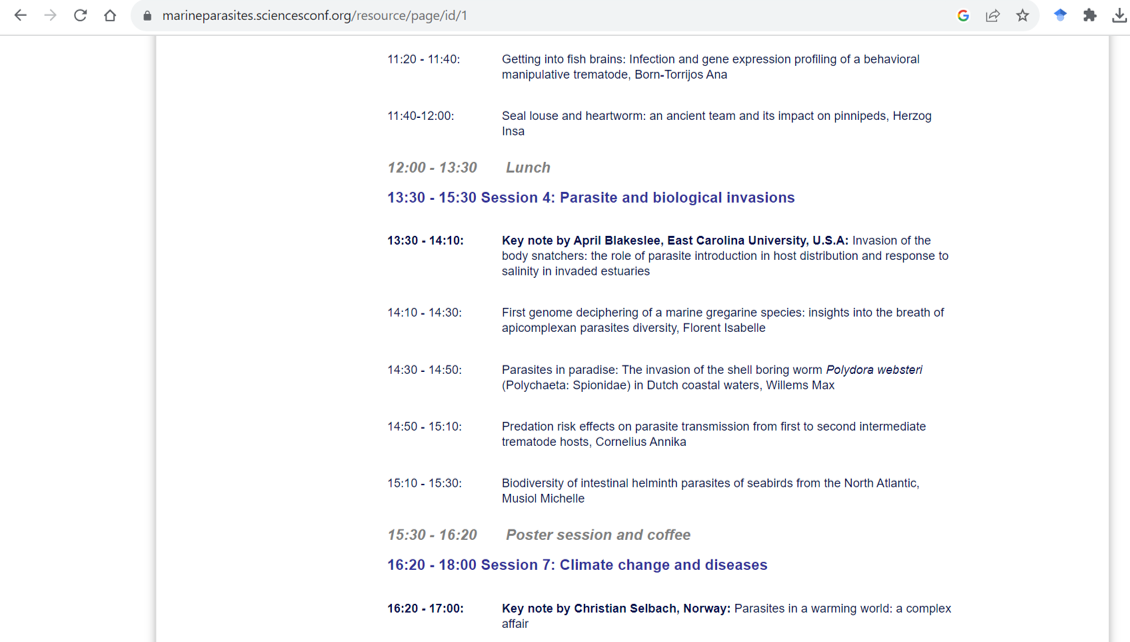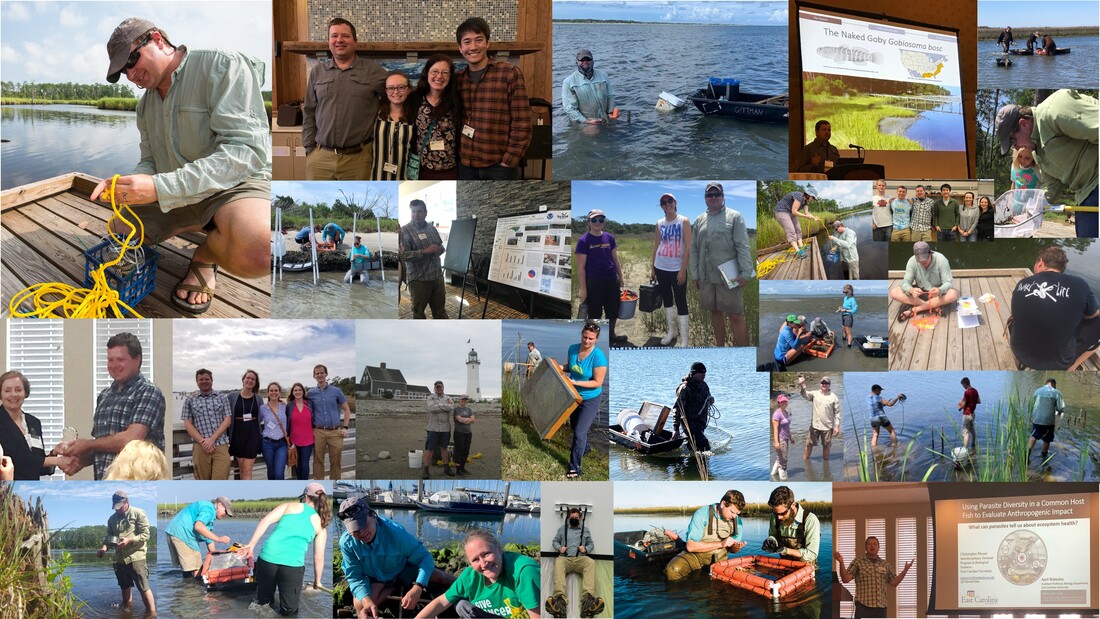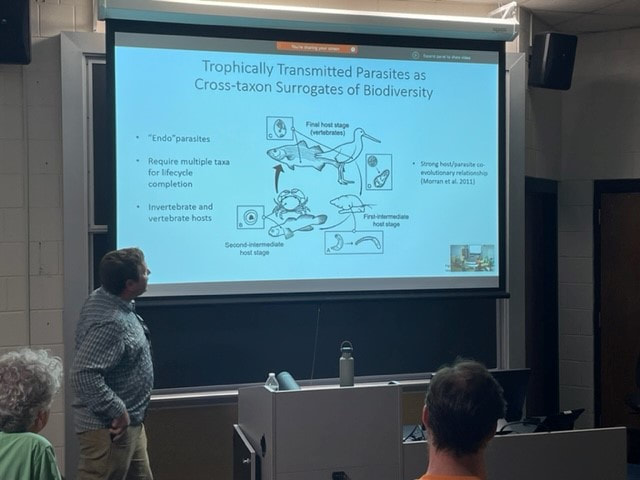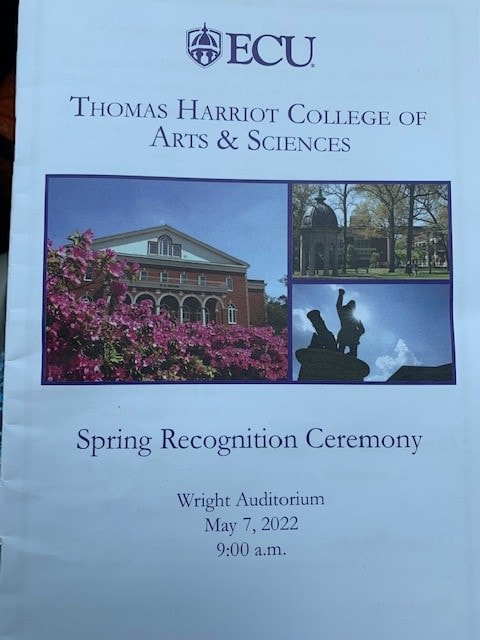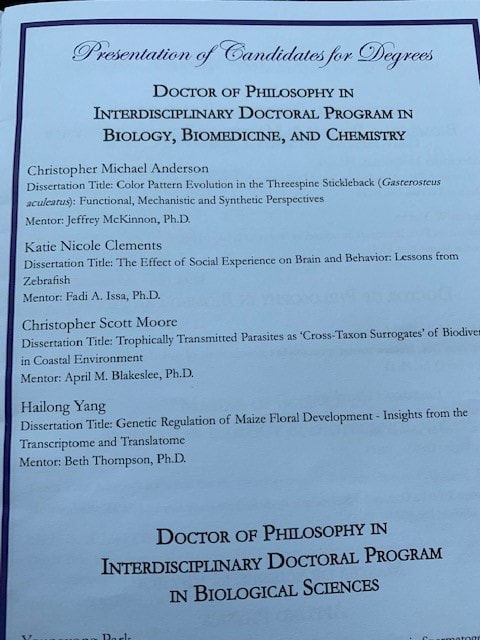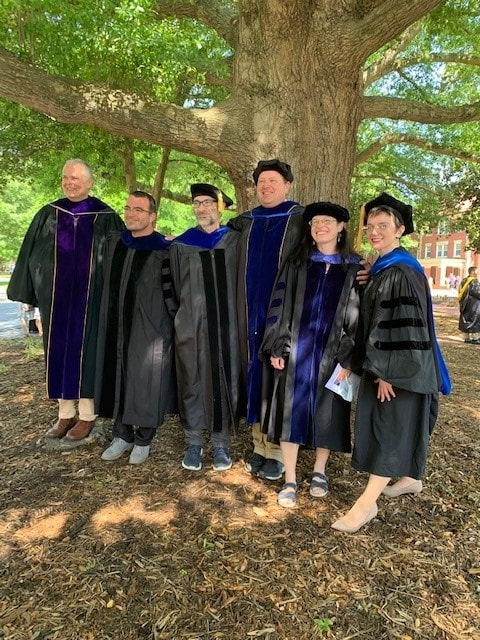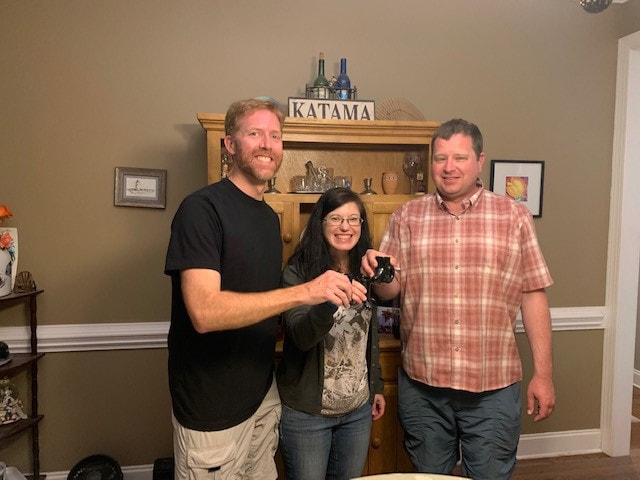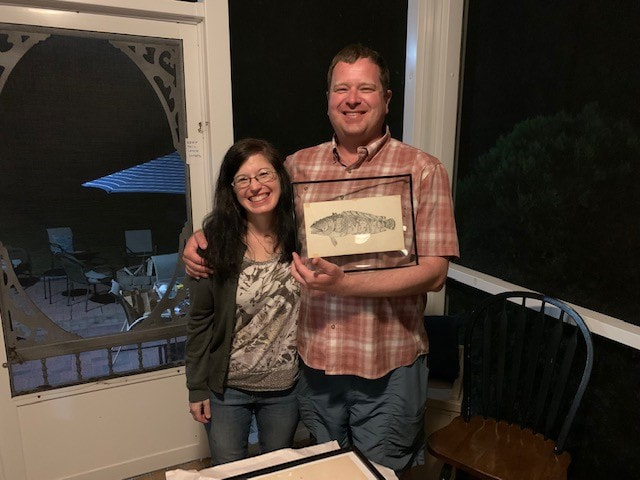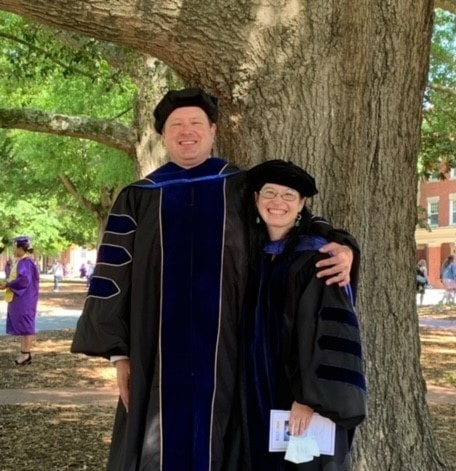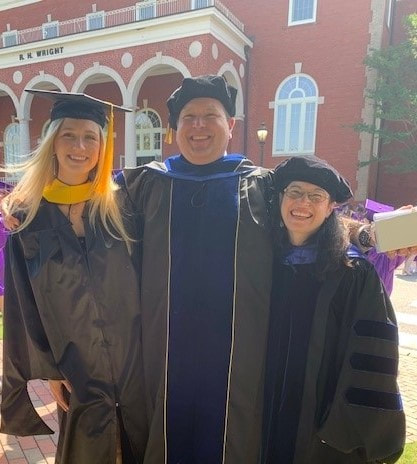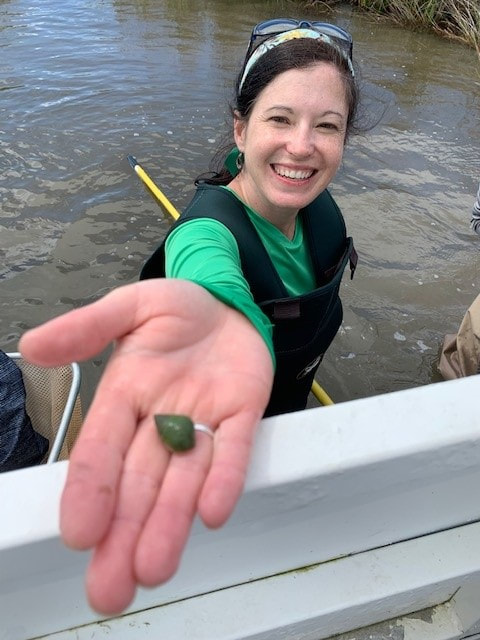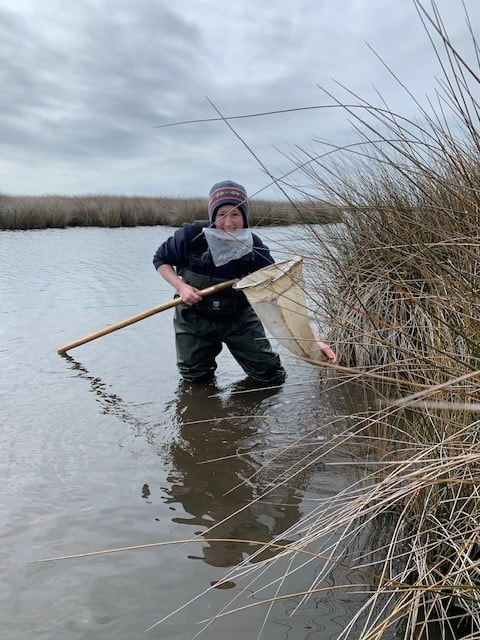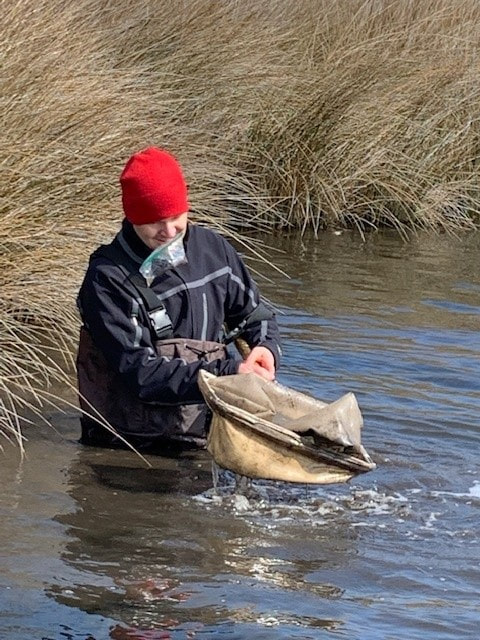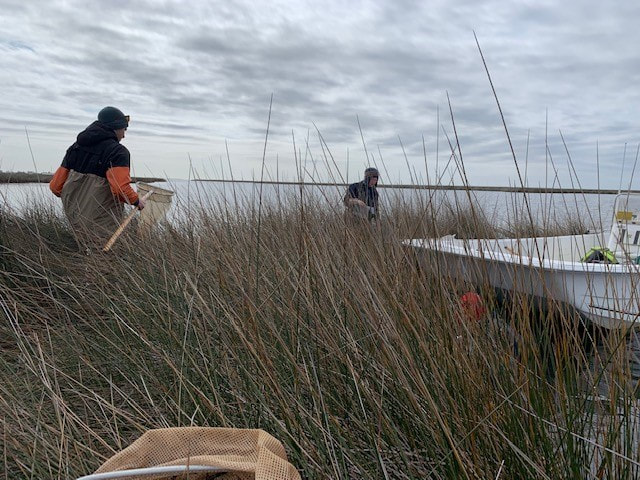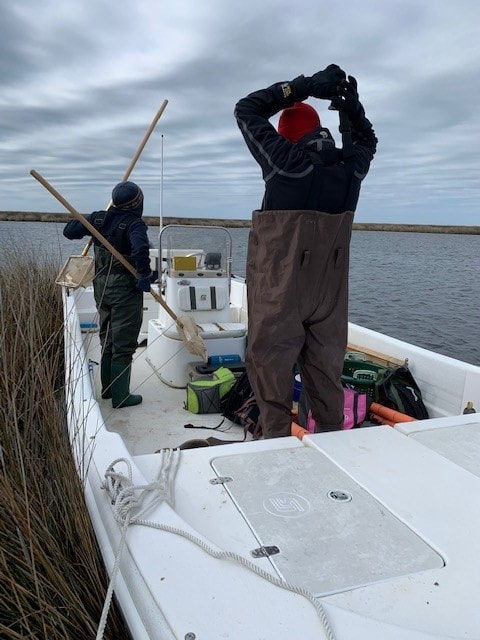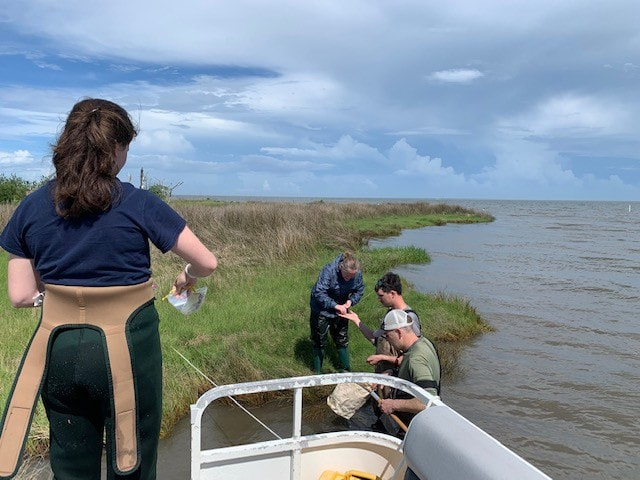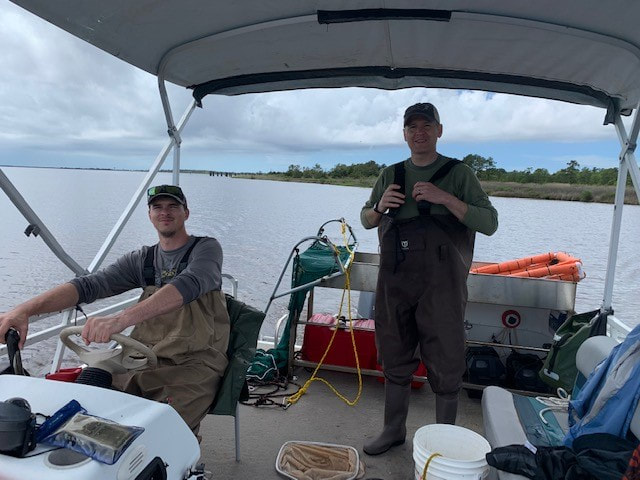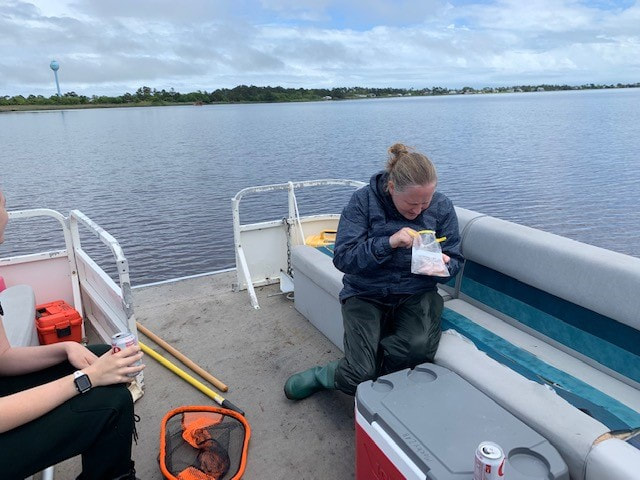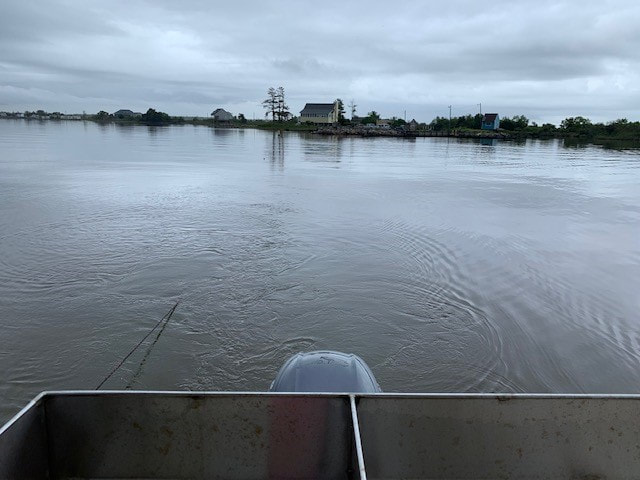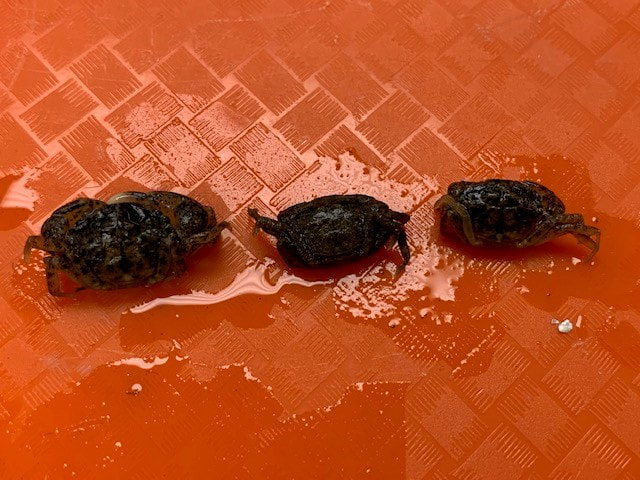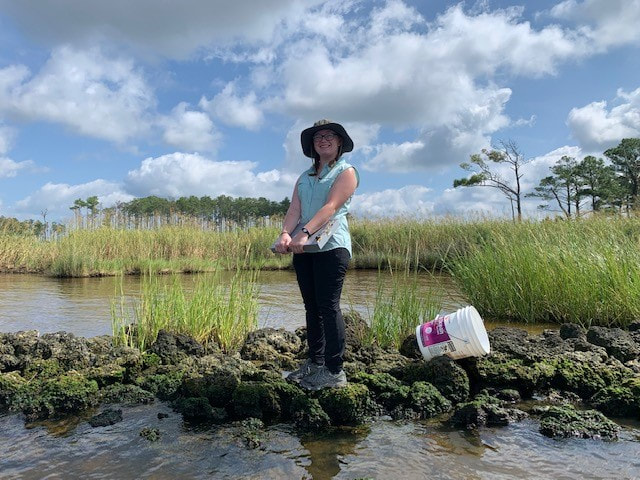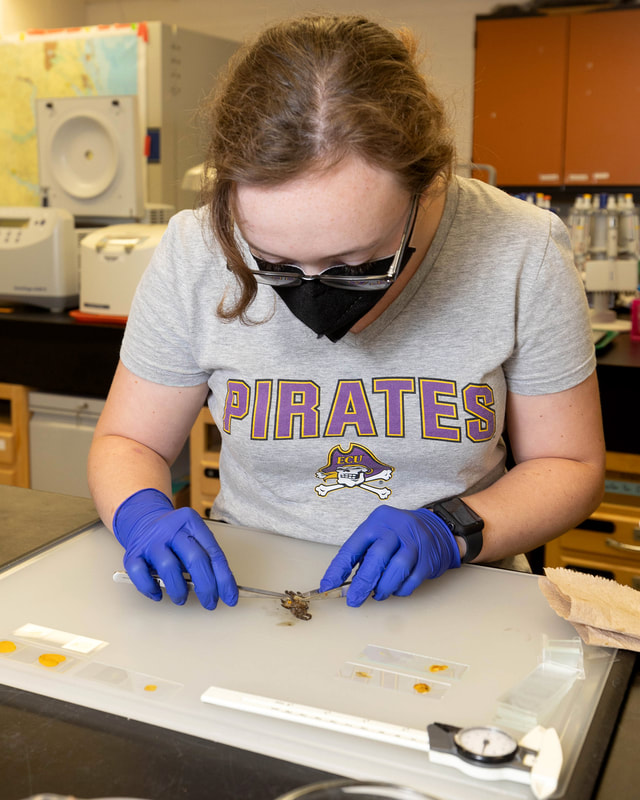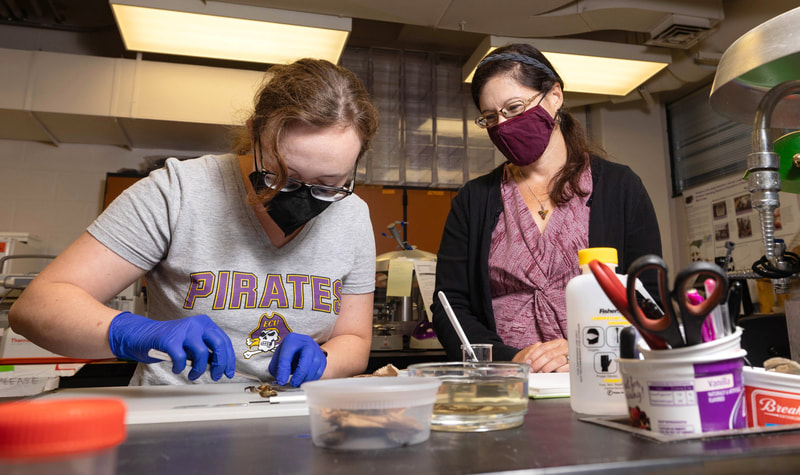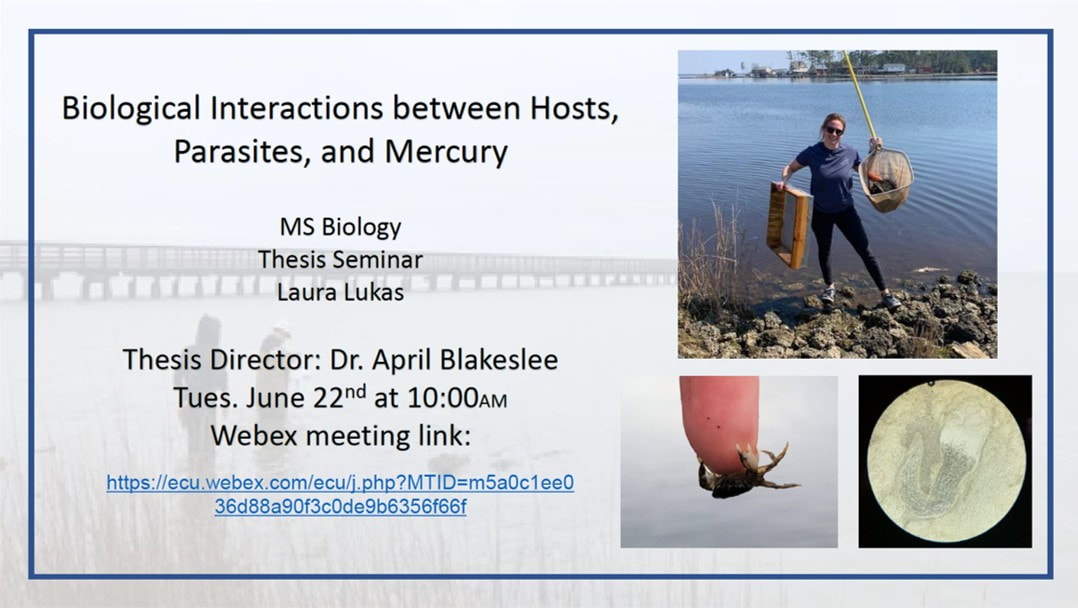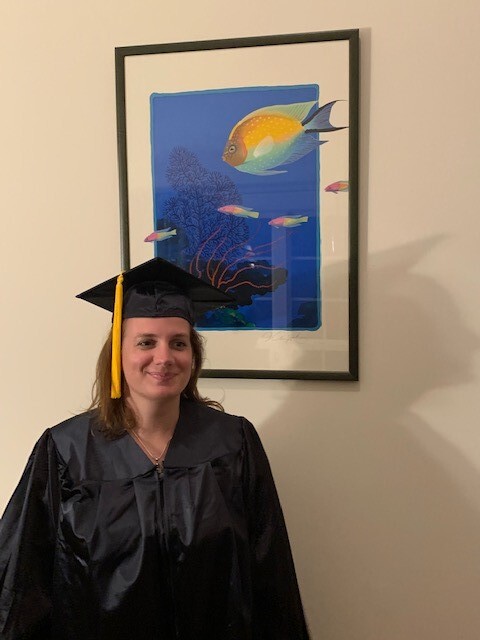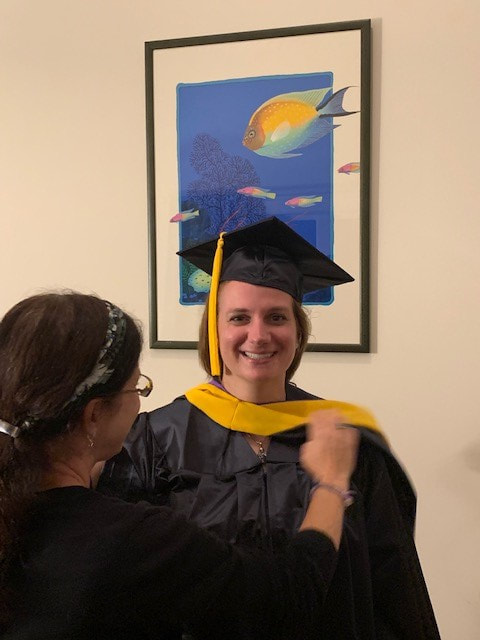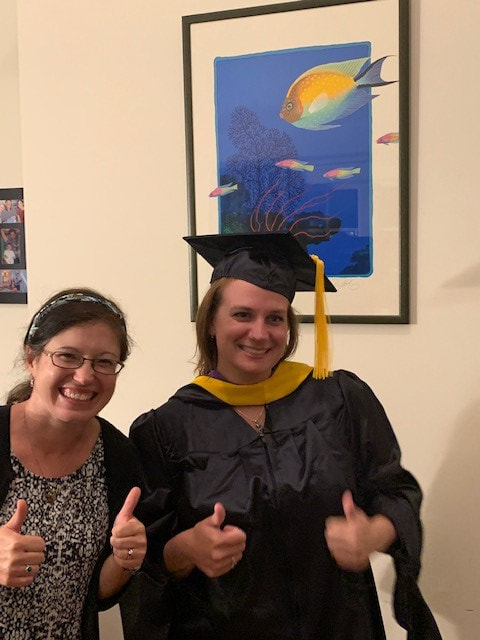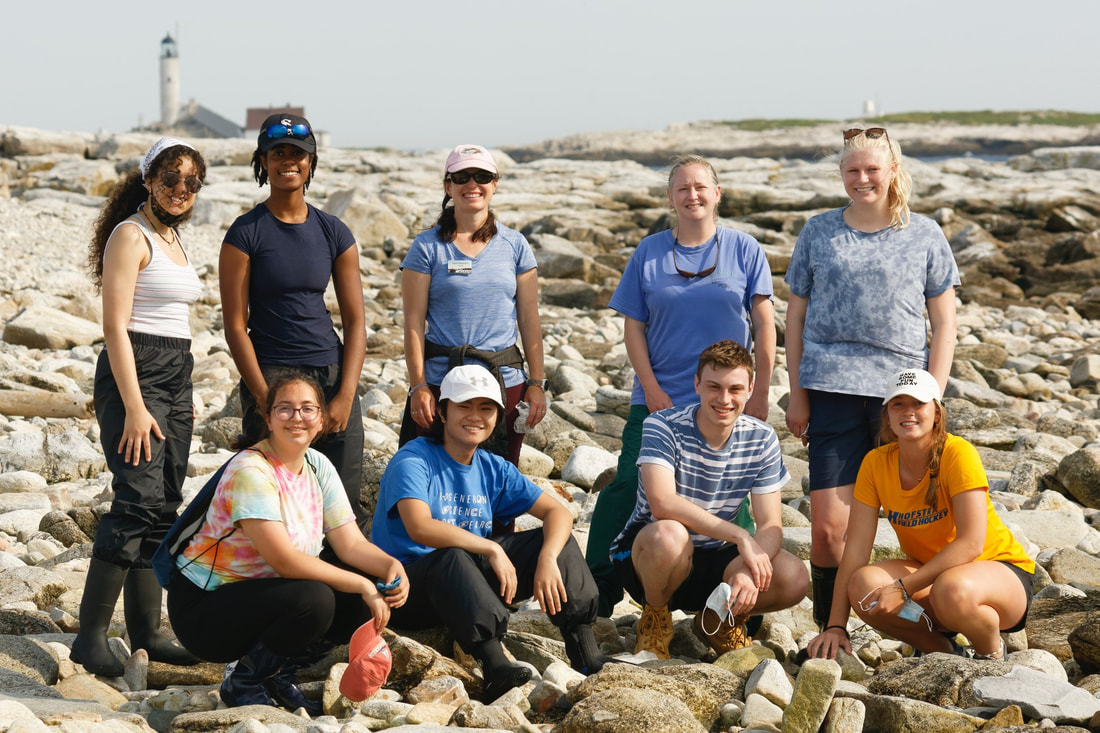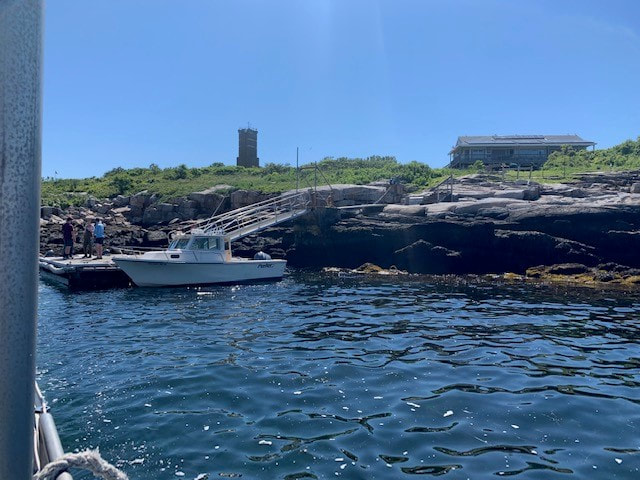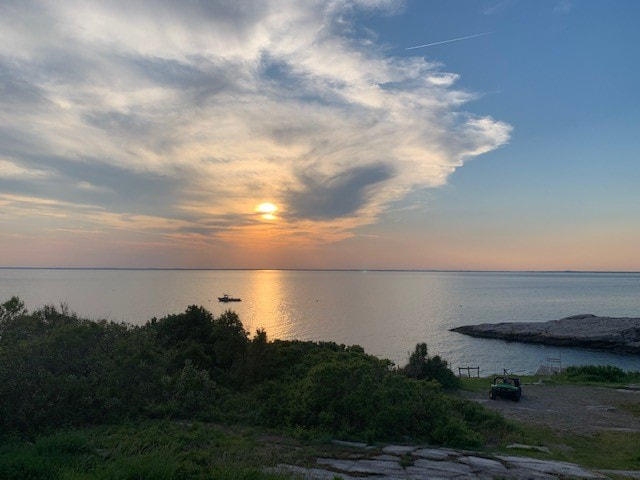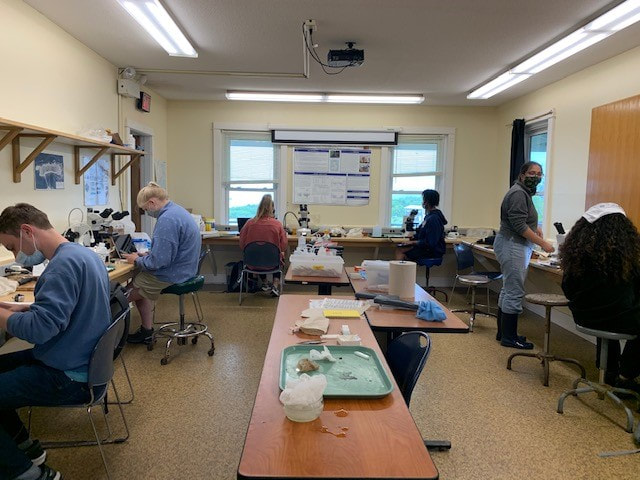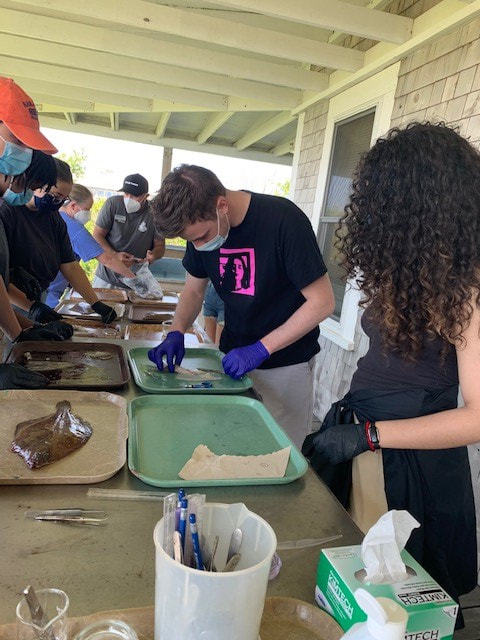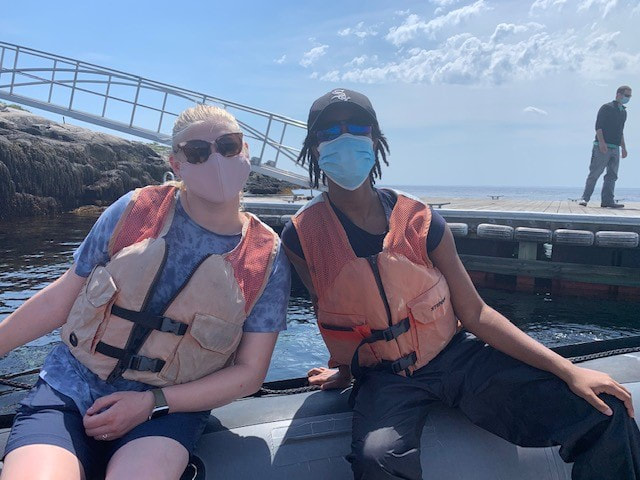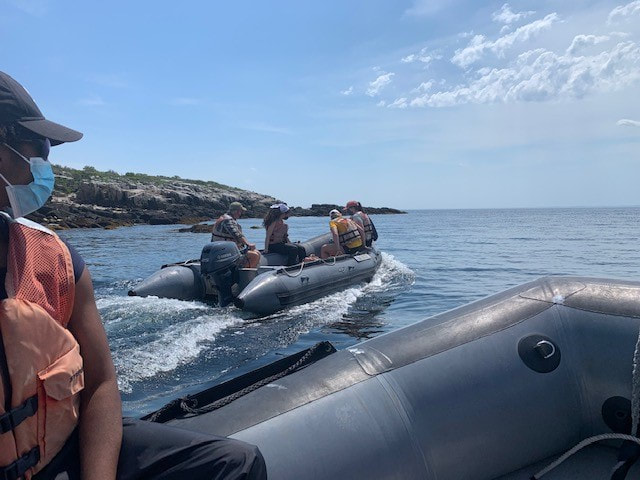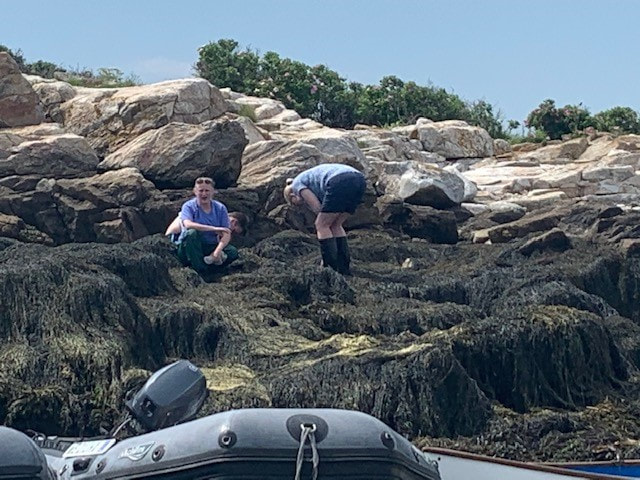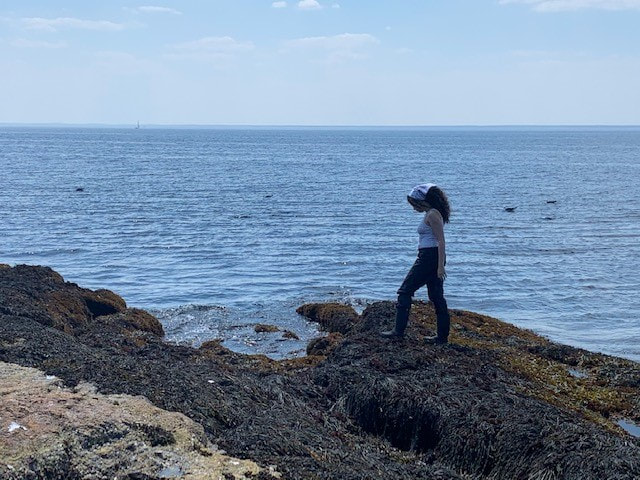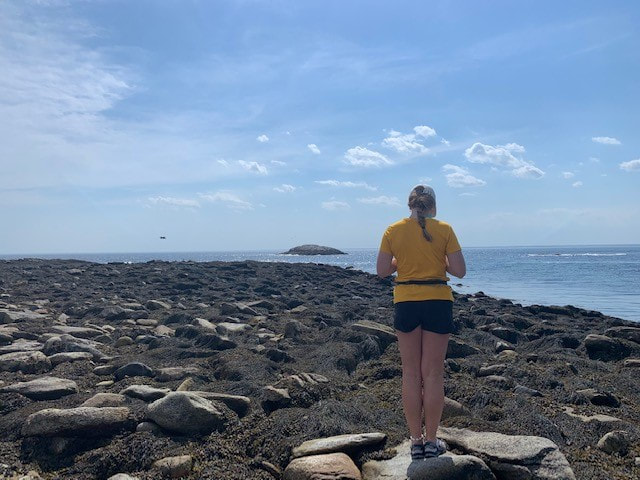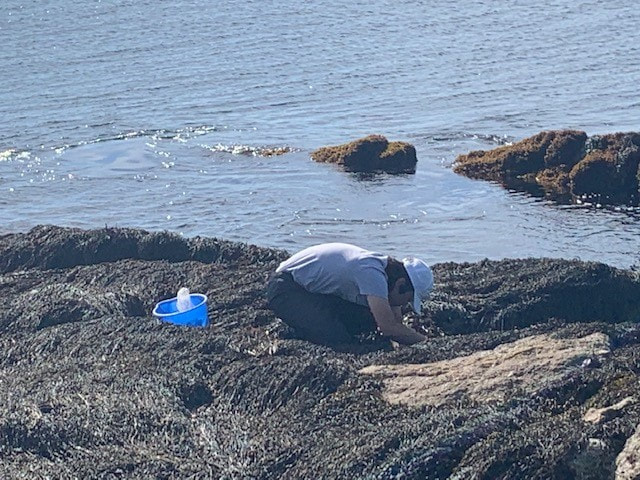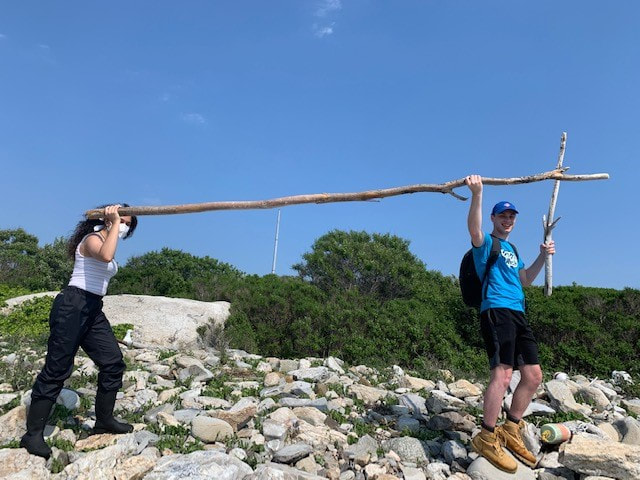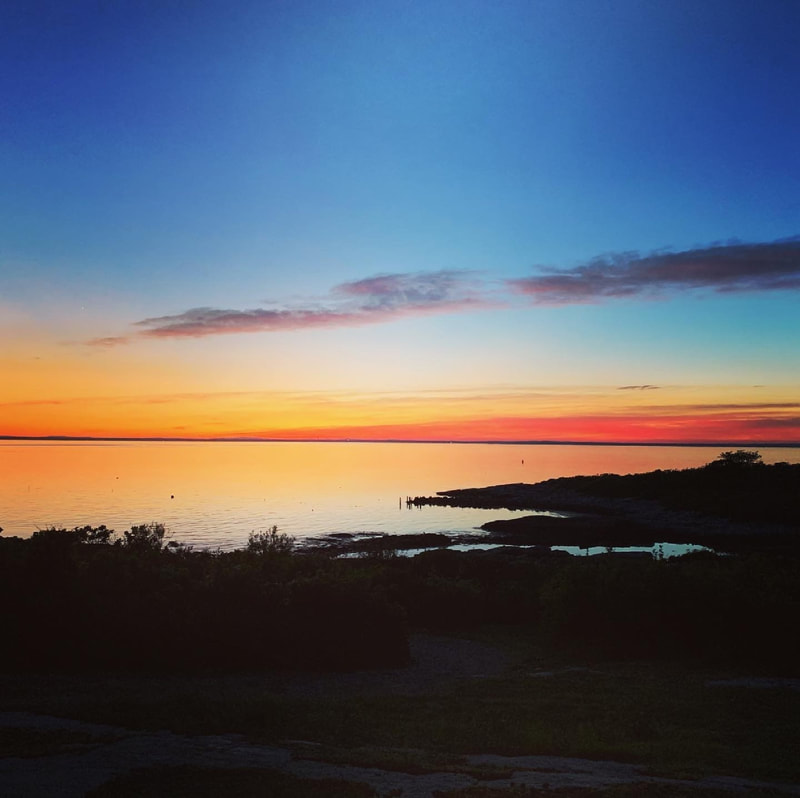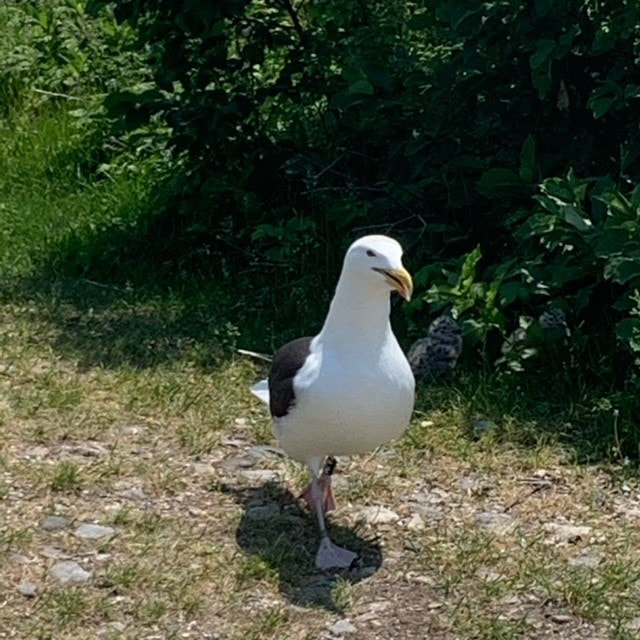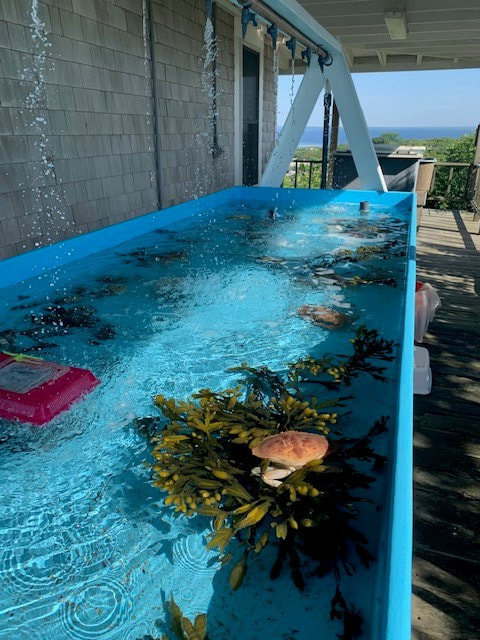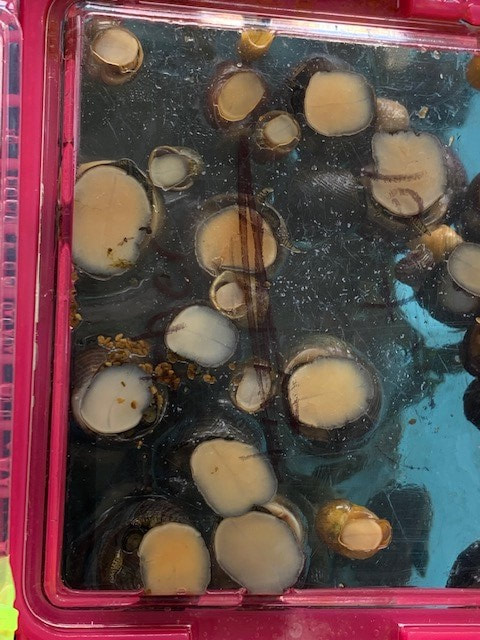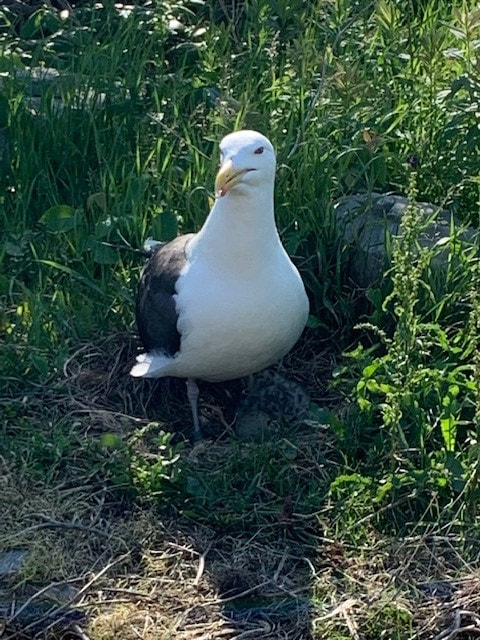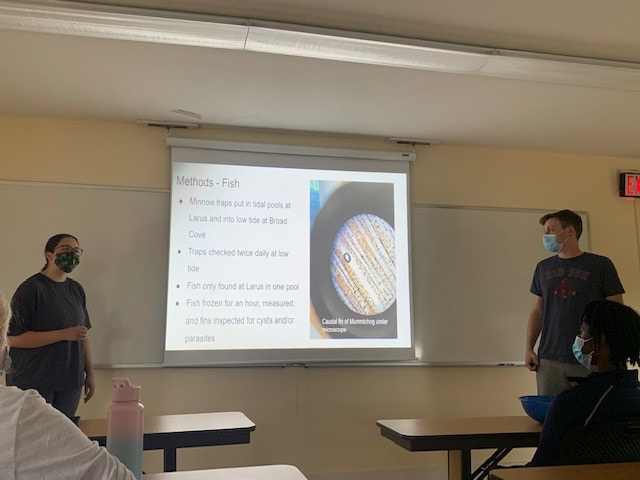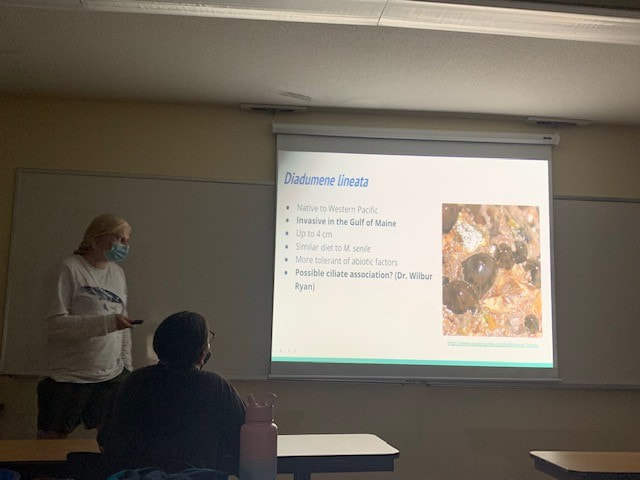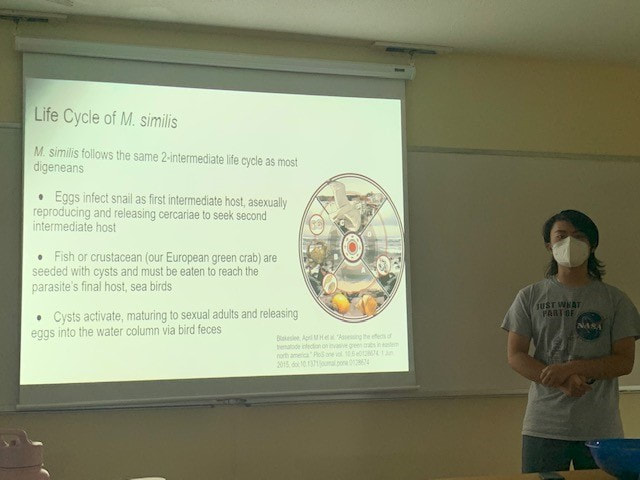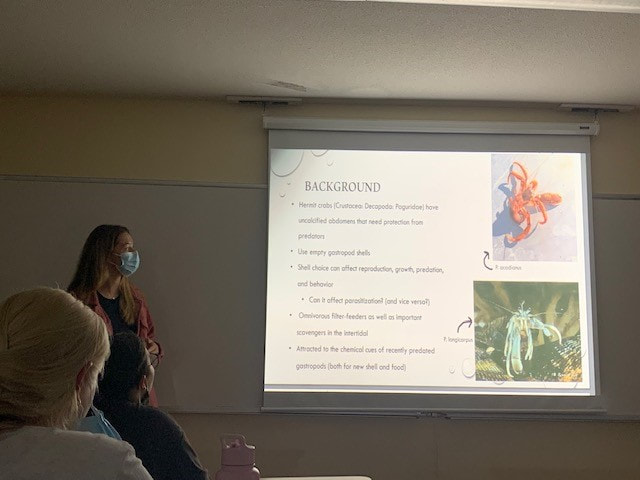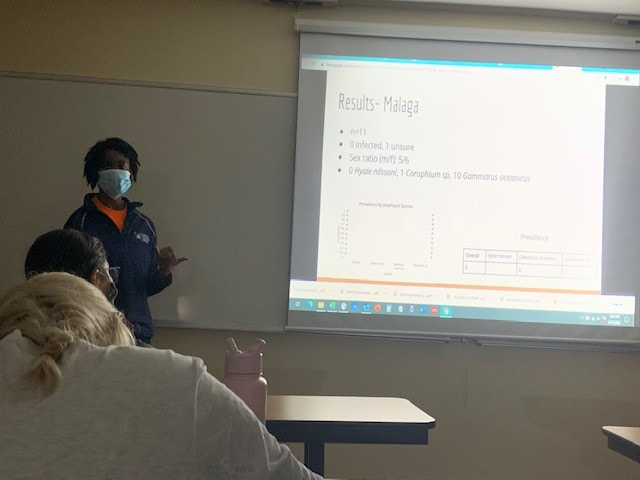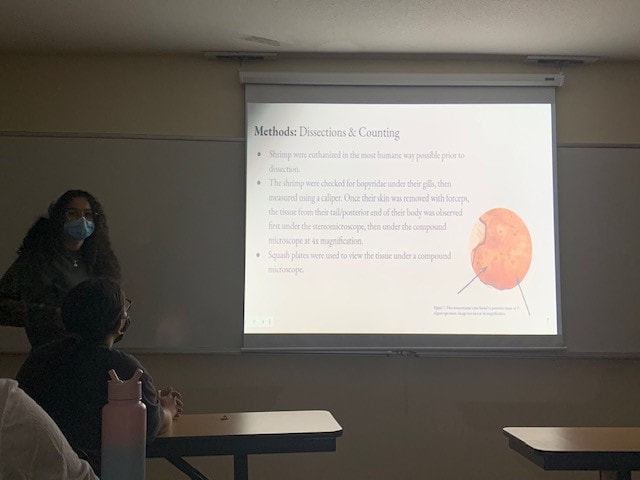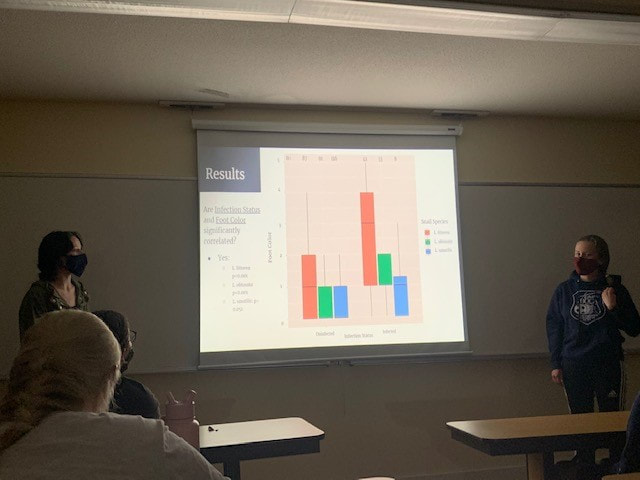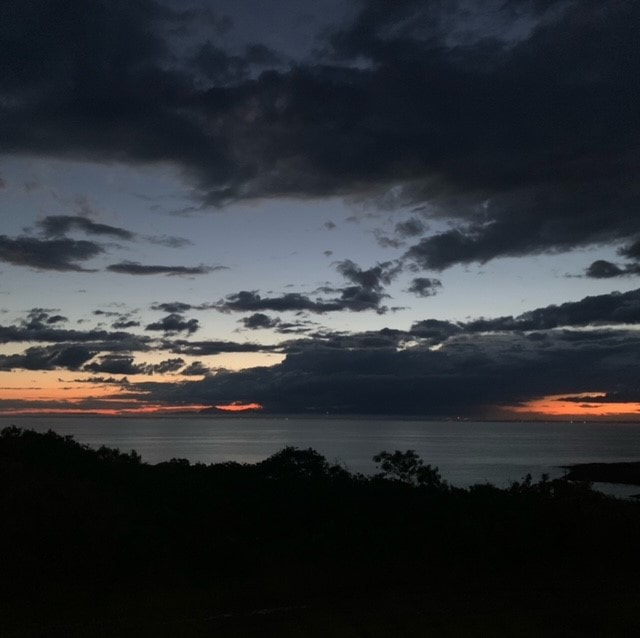|
Over the past couple of months, we've had a few stories in the media, including web blogs, an NPR story, and a local news report. One story related to our ongoing Zombie crab work (always fun to talk about near Halloween!) and the other stories focused on the June 2023 Mid-Atlantic Rapid Assessment Survey that our lab was part of. Very exciting! Here are the links to these stories below:
A YEAR IN REVIEW: Catching up on over a year's worth of events... (June 2022 - August 2023) :-O9/4/2023
The last year has been incredibly busy and productive, but I got way behind on my lab news posts... below is the last year in a nutshell - in chronologically reverse order. WELCOME TO NEW STUDENTS - Fall 2023 Welcome to Garrett Maggio (PhD student) and Mic Schulte (MS student), two new members of the lab! On August 26, they joined us right away for our seasonal field work of the Pamlico estuary for our zombie crab project. Much more field work to come! :) SHOALS MARINE LAB - June and August 2023: Marine Invasive Species (MIS) and Marine Parasitology & Disease (MPD) classes I once again had the opportunity to co-teach two classes out at Shoals Marine Lab this summer, which was so fun and so rewarding. The first two images come from our MIS class, co-taught by myself, Dr. Carrie Keogh, Dr. Amy Fowler, and Dr. Aaren Freeman, with my current MS student, Grace Loonam as our TA. The second two images come from our MPD class, co-taught by myself and Dr. Amy Fowler. In both classes, we had wonderful students. Looking forward to next year out on the island again... it's always been a very special place that has been a part of my academic journey for 30 years now. ISOLBE XIII (International Symposium on Littorinid Biology and Evolution) - July 2023 I served on the Scientific Steering committee for ISOLBE XIII (https://isolbexiii.com/), which took place in Porto, Portugal in July 2023. I presented a talk and also took part in multiple discussions, brainstorming and collaborations. It was so wonderful to be around an international group of people as passionate about snails as I am (especially of the Littorinidae family!!). My talk was entitled: "Phenotypic and genetic characterization of two prominent ecotypes in Northwest Atlantic populations of Littorina saxatilis" Inaugural Mid-Atlantic Rapid Assessment Survey (RAS) - June 2023 I assisted with the design and running of this first ever RAS, along with Dr. Amy Fowler, Dr. Jim Carlton, and Dr. Judy Pederson, focused on documenting fouling organisms associated with marina docks. We had an excellent team of ecologists and taxonomists working across multiple animal and algal taxa. My current PhD student, Carter Stancil, assisted during the RAS as well! Please see the recent write-up on this research in an ECU news story: https://news.ecu.edu/2023/08/16/ecu-involved-in-first-ever-survey-of-marine-bioinvasions-from-the-mid-atlantic/ There were so many pictures associate with this event... just posting a few below - the first photo is of all the participants! Participants of the 2023 inaugural Mid-Atlantic Marine Bioinvasions RAS. Front row, from left to right: El Hartshorn, Samantha Parsons, Rob Aguilar, Judy Pederson, Megan McCuller, Jim Carlton, April Blakeslee, Amy Fowler, Sarah Greenberg, Sara Labbe. Back row, left to right: Danielle Moloney, Drew Davinack, Clara Benadon, Niels Hobbs, Kristen Larson, Carter Stancil, Miranda Andersen, Carol Thornber. Haley Hagemeier successfully defends her MS thesis - June 2023! Congratulations to Haley Hagemeier, who defended her MS thesis on June 2, 2023. She gave a truly excellent presentation and pulled together a very nice thesis that we are actively working on her publication. Haley is now a PhD student at George Washington University. Congrats, Haley!! My lab attended the International Conference on Marine Bioinvasions (ICMB XI) in May 2023 All the graduate students in my lab, and myself, attended ICMB XI (https://marinebioinvasions.info/), which took place in Baltimore, Maryland in May 2023. This included two former students, Haley Hagemeier (MS) and Tim Lee (PhD), and current students, Chloe Gabriel (MS student), Carter Stancil (PhD student), and Grace Loonam (MS student). The conference was fun and productive - so many great conversations after a 5 year hiatus due to COVID. My students all did well, and Tim Lee even won a best presentation award!! Dr. Tim Lee and Haley Hagemeier graduate from ECU! Congratulations to two of my (now former) graduate students, Tim Lee and Haley Hagemeier, who attended ECU graduation for their PhD and MS, respectively. It was a wonderful day, and I was so proud of them!! Congratulations, Tim and Haley!! :-D Tim just started a new postdoc at UNC-Greensboro, and Haley just started a PhD at George Washington University. Congratulations to my former PhD student, Dr. Chris Moore, for winning the ECU Doctoral Dissertation Award! I was super proud that my former PhD student, Chris Moore, received the ECU dissertation award for his dissertation at ECU entitled: "Trophically transmitted parasites as cross-taxon surrogates." Chris was unable to attend, so I picked up the award on his behalf. What a fantastic honor!! CONGRATULATIONS TO DR. TIM LEE FOR SUCCESSFULLY DEFENDING HIS PHD DISSERTATION - April 2023 I was very proud that my former PhD stundent, Tim Lee, successfully defended his dissertation on April 6, 2023. His dissertation is entitled: "Diversity and survival of macrofauna associated with a non-native foundational species." Tim gave an excellent presentation and he is working on publishing his chapters. Tim is now doing a postdoc at University of North Carolina-Greensboro. Graduate and undergraduate students in my lab present at ECU's annual Research and Creativity Achievement Week (RCAW) - April 2023 Several members of my lab presented posters or oral presentations at the 2023 RCAW event. This included: Grace Loonam (MS student), Chloe Gabriel (MS student), Haley Hagemeier (MS student), Carter Stancil (PhD student), Chloe Manning-Moore (undergraduate student), Carrie Adams (undergraduate student), Amanda Riggs (undergraduate student), and Trip Brooks (undergraduate student). I did a thing!! Nerd Nite - March 2023. I presented at Nerd Nite on March 31, 2023 during our graduate student recruitment event. It was really fun and a great venue to present on how cool parasites are. SO COOL! CARTER STANCIL RECEIVES A GRADUATE RESEARCH FELLOWSHIP (GRF) FROM THE NATIONAL SCIENCE FOUNDATION - March 2023!! In absolutely spectacular news, Carter Stancil, received a GRF from NSF. This provides her with 3 years of funding towards her PhD. It is truly a great honor that Carter received this very competitive fellowship. So proud to be assisting her on her dissertation journey! Click here for an ECU news story about Carter's accomplishment! https://biology.ecu.edu/stancil_nsf_grfp/ ICES Working Group on the Introduction and Transfers of Marine Organisms (WGITMO) Annual Meeting in Athens, Greece - March 2023 I attended the annual meeting of ITMO in Athens, Greece this year, and it was a truly spectacular meeting. I delivered the US National Report and also presented a talk on climate related species range expansions on the Atlantic Coast. A recent ECU news story discussed my work with this group - please see here: https://news.ecu.edu/2023/05/22/aquatic-environmental-changes/ The images below show our working group as well as the women involved for National Women's Day! Chris Moore publishes a chapter from his dissertation in Ecological Applications - February 2023 Chris successfully published one of his dissertation chapters in the prestigious journal, Ecological Applications. The paper is entitled, "Parasites indicate trophic complexity and faunal succession in restored oyster reefs over a 22-year period", and can be found here: https://esajournals.onlinelibrary.wiley.com/doi/10.1002/eap.2825 Here is a Tweet from the journal about the publication: https://twitter.com/ESAApplications/status/1630948003401068544 Keynote speaker for the International symposium of ecology and evolution of marine parasites and diseases in La Rochelle, France - November 2022 I was invited to be one of the keynote speakers at this parasites focused symposium which took place in France in November 2022. I felt incredibly honored to have been selected as one of the invited speakers. The website for the meeting can be found here: https://marineparasites.sciencesconf.org/. I also took the opportunity to do some opportunistic sampling and to meet researchers while in France... also a bit of sight-seeing along the way. :) Outreach event: community science festival - November 2022 On November 5, our lab participated in a community science festival organized by ECU in which the public was invited to learn about science and community outreach. We talked about our lab's work in several conservation related areas, including biodiversity and invasive species. And visitors got to meet "zombie crabs"! Shoals Marine Lab Courses in Summer 2022: Marine Parasitology & Disease, and Marine Invasive Species We had an amazing time teaching these courses in 2022, and it was the first time for our newly designed MIS class. See pictures below... Shoals is always amazing, and our students were fantastic. I am so proud to have graduated my first PhD student, Dr. Chris Moore! Below is a collage of images from the past 6 years of Chris working in the Blakeslee lab: Here is the introduction I gave about Chris before he delivered an excellent defense talk!
My first experience with Chris was when I put out an ad for graduate students on a listserv back in 2015 shortly after I started at ECU, and he wrote to me with an enthusiastic email that immediately made him stand out among others that contact me. Chris had really looked into my research and spoke of how he might be able to move my research program forward. And that is truly what he did. Chris was one of my first students, along with Becca Barnard who is on Webex with us, and they both really got my lab going. The year that Chris was accepted, he started early and assisted on a side project, which ultimately led to a publication where he was a co-author. Chris has assisted on so many projects not only with my lab, but with others. He is incredibly generous with his time and is always enthusiastic about everything he does. He also works incredibly hard, and has pulled together some really fascinating research as he will talk about very soon. As a result of his research efforts, he is first or co-author on 5 publications already, with 3 additional publications in review and 1 in prep. One first-authored paper currently in review is in the journal Ecology, and it is past the desk rejection stage, which is very exciting! He has also applied for and received an incredible number of grants during his time at ECU. These include: Golden Key International Academic Honor Society, Society for Integrative & Comparative Biology, Sigma Xi, Garden Club of America, American Malacological Society, N.C. Coastal Conservation Association, N.C. Sea Grant / National Estuarine Research Reserve, N.C. Wildlife Federation, and the Lerner-Gray Fund for Marine Research. Altogether, this has totaled over 26,000, which is an incredible achievement for acquiring research funding to fund his work as a graduate student. Chris has also received multiple awards for talks, posters, and other competitions, including RCAW, Sigma Xi, SEERS conference, American Fisheries Society, CERF, AFS Tidewater. At ECU, he has had many leadership roles including in BGSA and AFS and has volunteered his time at many ECU events. He has also had an important teaching role in the department, at first TA’ing the Ecology lab and most recently as an instructor of BIOL 1050. Chris consistently receives high praise from students for his teaching and mentorship. Speaking of mentorship, he has mentored 9 undergraduate students in the department, including helping to mentor an honors thesis research project completed by Corey Winkler. He has also been incredibly generous of his time in terms of experimental design and statistical analysis for many students in my lab and in other labs. All these accomplishments demonstrate the high quality work that Chris has done over the years and what a truly good person he is. It’s hard to imagine my lab without him in it, but I know we will continue to collaborate into the future and stay friends. And finally a bunch of pictures of the defense, his celebration party, and graduation! This past spring we started a new project with Jim Morley's lab at ECU to examine black gill disease prevalence in the Pamlico Sound, where very little on the disease is thus far known in the region. We will use morphological and PCR-based approaches to try to get a better understanding of prevalence in these populations, since not all infected shrimp will be obviously symptomatic. We also intend to see if panopeid shrimp may serve as a reservoir of infection for panaeid shrimp in the region.
We just got a paper published in Arthropod Systematics & Phylogeny that reassesses Eubrachyura systematics with the inclusion of several mitogenomes of panopeid species mud crabs. The paper can be found here: https://arthropod-systematics.arphahub.com/articles.php?id=70234
Systematic assessment of the Panopeidae and broader Eubrachyura (Decapoda: Brachyura) using mitochondrial genomics Lucas A. Jennings, April M. H. Blakeslee, Krista A. McCoy, Donald C. Behringer, Jamie Bojko Abstract This study provides a broad phylogenetic analysis for the Eubrachyura, with the inclusion of three new Panopeidae mitochondrial genomes: Eurypanopeus depressus (flatback mud crab) (15,854bp), Panopeus herbstii (Atlantic mud crab) (15,812bp) and Rhithropanopeus harrisii (Harris, or ‘white-fingered’ mud crab) (15,892bp). These new mitogenomes were analyzed alongside all available brachyuran mitochondrial genomes (n = 113), comprising 80 genera from 29 families, to provide an updated phylogenetic analysis of the infra-order Brachyura (“true crabs”). Our analyses support the subsection Potamoida within the Eubrachyura as the sister group to Thoracotremata. The family Panopeidae aligns with the family Xanthidae to form the Xanthoidea branch, which is supported by current morphological and genetic taxonomy. A unique gene arrangement termed ‘XanGO’ was identified for the panopeids and varies relative to other members of the subsection Heterotremata (within the Eubrachyura) via a transposition of the trnV gene. This gene arrangement is novel and is shared between several Xanthoidea species, including Etisus anaglyptus (hairy spooner crab), Atergatis floridus (brown egg crab), and Atergatis integerrimus (red egg crab), suggesting that it is a conserved gene arrangement within the Xanthoidea superfamily. Our study further reveals a need for taxonomic revision of some brachyuran groups, particularly the Sesarmidae. The inclusion of panopeid mitogenomes into the greater brachyuran phylogeny increases our understanding of crab evolution and higher level Eubrachyuran systematics. A warm welcome to Haley Hagemeier who joined the Blakeslee lab in August 2021 as a MS student. She has hit the ground running, helping us in the field in late August and presently doing an independent biogeography project on parasite diversity in invasive Asian shorecrabs (Hemigrapsus sanguineus) from sites ranging from Maine to North Carolina, which is part of a larger collaborative project. She is also developing her masters research project which will examine physiological tolerances to salinity of two native mud crabs that are infected by the "body-snatching" rhizocephalan parasite that we study in the lab: Loxothylacus panopaei. We want to determine if the crabs can survive low salinity waters that could provide a refuge from this castrating, impactful parasite. She will be also be investigating whether there is differential susceptibility to infection in the two crab species using lab experiments.
It was very exciting that two publications came out of my lab this summer! The first is a lab-wide projecting exploring the influence of salinity gradients on parasite prevalence in mud crabs of an invasive body-snatching parasite. The second is an international trans-Atlantic collaboration of two related Littorina snail species that show strong differences in their phylogeographies, partly due to opposing reproductive strategies. See the titles, authors, abstracts, and links below.
(1) Invasion of the body snatchers: the role of parasite introduction in host distribution and response to salinity in invaded estuaries. Blakeslee AMH, Pochtar DL, Fowler AE, Moore CS, Lee TS, Barnard RB, Swanson KL, Lukas LC, Ruocchio M, Torchin ME, Miller AW, Ruiz GM, Tepolt CK (2021) Proceedings of the Royal Society Series B Biology. 288: 20210703. https://royalsocietypublishing.org/doi/10.1098/rspb.2021.0703 Abstract: In dynamic systems, organisms are faced with variable selective forces that may impose trade-offs. In estuaries, salinity is a strong driver of organismal diversity, while parasites shape species distributions and demography. We tested for trade-offs between low-salinity stress and parasitism in an invasive castrating parasite and its mud crab host along salinity gradients of two North Carolina rivers. We performed field surveys every six to eight weeks over 3 years to determine factors influencing parasite prevalence, host abundance, and associated taxa diversity. We also looked for signatures of low-salinity stress in the host by examining its response (time-to-right and gene expression) to salinity. We found salinity and temperature significantly affected parasite prevalence, with low-salinity sites (less than 10 practical salinity units (PSU)) lacking infection, and populations in moderate salinities at warmer temperatures reaching prevalence as high as 60%. Host abundance was negatively associated with parasite prevalence. Host gene expression was plastic to acclimation salinity, but several osmoregulatory and immune-related genes demonstrated source-dependent salinity response. We identified a genetic marker that was strongly associated with salinity against a backdrop of no neutral genetic structure, suggesting possible selection on standing variation. Our study illuminates how selective trade-offs in naturally dynamic systems may shape host evolutionary ecology. (2) Population structure and phylogeography of two North Atlantic Littorina species with contrasting larval development. Blakeslee AMH, Miller AW, Ruiz GM, Johannesson K, André C, Panova M (2021). Marine Biology. 168: 1-16. https://doi.org/10.1007/s00227-021-03918-8 Abstract: Phylogeography provides insights into how historical and contemporary processes influence the genetic structure and gene flow in marine organisms around the globe. In benthic marine invertebrates, a species’ reproductive strategy can strongly impact phylogeographic patterns and distribution, with some direct-developing (non-planktonic) dispersers demonstrating strong genetic structure but also broad geographic spread. While seemingly paradoxical, past work has shown ovoviviparous species, like Littorina saxatilis, can be more successful colonizers of remote locations than species with planktonic larvae, like L. littorea. Both Littorina species overlap in much of their North Atlantic ranges but have different colonization histories: L. saxatilis is native on both North Atlantic coasts and islands, and L. littorea is native to the eastern Atlantic but introduced to the west. Using an extensive mitochondrial dataset (1236 sequences; 85 sites), we examined how their opposing reproductive strategies correspond to their distributions and phylogeographies. Littorina saxatilis exhibited a heterogeneous genetic structure reflecting post-glacial recolonization from multiple refugial sites, while L. littorea had a homogeneous structure with a post-glacial history characterized by recolonization from one main refugial area in the northeast Atlantic. Further, haplotype diversity was significantly depressed in northwest Atlantic L. littorea populations, signifying a strong bottleneck characteristic of a human-mediated introduction. In contrast, haplotype diversity in L. saxatilis was similar between the two regions, demonstrating long-term history on both coasts. Thus, our study suggests contrasting life-history characteristics were a major structuring force in the phylogeographic patterns of these related species following large-scale disturbances (natural and anthropogenic) that compel contraction and redistribution over large areas. Laura did an excellent job with her thesis defense, managing to collect her data during the pandemic and then pulling together a nice thesis and presentation. Very proud of her hard work over the past 2 years!!
We were very excited that our course was able to run again this summer. Amy and I had an absolutely fantastic group of students (see lots of pics below) and it was such a fun teaching experience! It was so nice to once again instruct about the wonders of parasites in a hands-on environment where the students could design their own short projects. So happy to have been a part of this wonderful group of students, along with the other amazing Shoals faculty and staff this summer!
|
|
